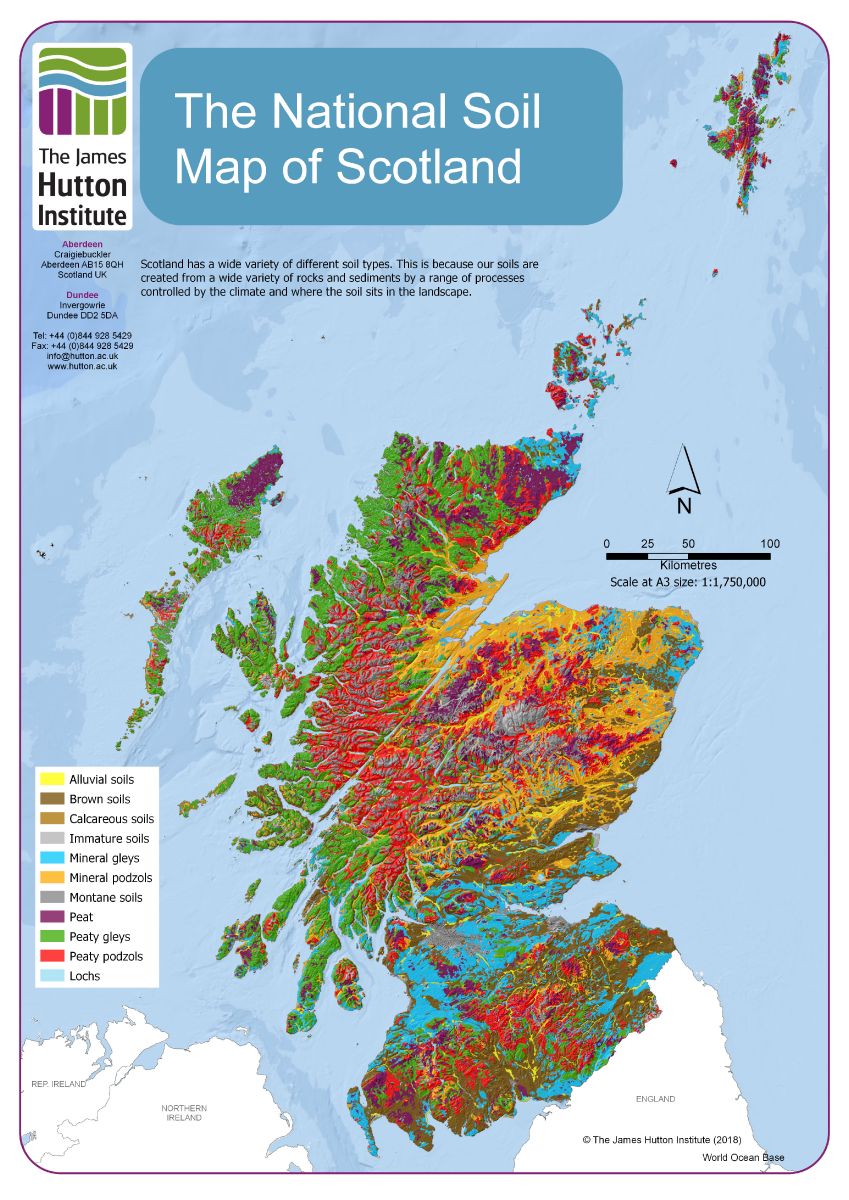National Soil Map of Scotland
The systematic survey of the soils of Scotland was commenced in 1947 by staff of the Macaulay Institute for Soil Research. This dataset is the digital (vector) version of the Soils of Scotland 1:250,000 maps, which is a generalised soil map, partly derived from a 1:50,000 map of the soils of Scotland. This dataset is an inventory of the soils of Scotland and was intended for use by planners etc. This dataset has the soil lines extrapolated over the built-up areas. The soil classification used was updated in 2013 to provide a unified classification across all Soil Survey of Scotland soil maps and profile datasets(UCSS). Version 1.1 of the data includes both the original 1984 and the 2013 soil classification. Version 1.2 of the data included an updated classification table. Version 1.3 of the data include some minor polygon corrections and further revisions to the classification table. Version 1.4 of the data includes some alterations to the symbology used for display.
Default
- Alternate title
-
Soils of Scotland 1:250,000 Soils vector
- Alternate title
-
qmsoils
- Date ()
- 1981-01-01
- Identifier
-
qmsoils_2013
- Presentation form
- mapDigital
The James Hutton Institute
-Colin Campbell
(Chief Executive
)Craigiebuckler
,Aberdeen
,AB15 8QH
,United Kingdom
The James Hutton Institute
-David Donnelly
(Research Scientist
)Craigiebuckler
,Aberdeen
,AB15 8QH
,United Kingdom
- Maintenance and update frequency
- irregular
- Name
-
ESRI Shapefile
- Version
-
1.0
- Keywords
-
-
soil
-
land form
-
base material
-
- GEMET - INSPIRE themes, version 1.0 ()
-
-
Soil
-
- Access constraints
- otherRestrictions
- Other constraints
-
no limitations on public access
- Use constraints
- The James Hutton Institute Open Data Licence
- Use constraints
-
This data was produced at a scale of 1:250,000. Larger scale data is available for the main agricultural areas of Scotland. Use is permitted under the terms of the Open Data licence included in the download.
- Spatial representation type
- vector
- Denominator
- 250000
- Metadata language
- eng (en)
- Topic category
-
- Farming
- Geoscientific information
- Geographic identifier
-
GB-SCT
))
- Reference system identifier
-
EPSG
/OSGB 1936 / British National Grid (EPSG:27700)
/7.9
- Distribution format
-
-
ESRI Shapefile
(1.0
)
-
Distributor
The James Hutton Institute
-David Donnelly
(Research Scientist
)Craigiebuckler
,Aberdeen
,AB15 8QH
,United Kingdom
- Fees
-
None
- Ordering instructions
-
Download from http://www.hutton.ac.uk/sites/default/files/files/soils/downloads/Hutton_Soils250K_OpenData.zip
- Turnaround
-
None
- Name
-
ESRI Shapefile
- Version
-
1.0
- OnLine resource
-
ESRI Shapefile Download
(
WWW:DOWNLOAD-1.0-http--download
)
- OnLine resource
-
0
(
OGC:WMS
)National Soil Map of Scotland
- Scope
- dataset
- Statement
-
Data gathering: Start: 01/01/1947, End: 01/01/1981
Collection methods: The digitising of this dataset was done by Laser-Scan, Cambridge. A film version of the lines was used as a source document for scanning. Dyeline prints of the soil lines were symbolized by hand and used as the source document for coding the polygons. The data was supplied in GIMMS format, and was first used for a joint venture with the Institute of Hydrology, who produced a raster version of the data at a resolution of 100 metres. In the course of this work they discovered and resolved many problems with edge-matching, errors in coding etc, which had not come to light previously. During this work soil boundaries were extended over all the built-up areas on the maps. The vector data was converted to a more useable format in the mid-eighties. Vector strings and arc-polygon labels were read from the GIMMS format, written to textfiles and used to produce plots to assist with the LCF map series. Later the vectors were imported into ARC/Info and a method devised for labelling the polygons. A more rigorous check of the accuracy of the dataset was done, which revealed coding and positional errors. The dataset can be considered as being composed of three layers: soil boundaries, lochs and coastline. These layers vary in their absolute and relative positional accuracy, when compared with the source 1:50,000 documents. Localised errors of up to 200 m have been observed in the lochs layer (possibly due to a mis-registration of plates during the reprographics phase of map production) and also therefore in common boundaries with soil polygons. It was accepted that it would take an inordinate amount of time to correct all the errors and that the best that could be done would be to check and correct the coding of polygons and any gross positional errors of soil boundaries. This work was done using the original data (vector, with built-up areas) and a dataset named Soils of Scotland 1:250,000 Soils and Built-up Area vector was produced. It was from this basic dataset that this dataset the Soils of Scotland 1:250,000 Soils vector was created. Raster versions of both vector datasets were made at resolutions of 100 metres and 1 kilometre.
Originator: Formerly DAFS (Department of Agriculture and Fisheries for Scotland), then SOAEFD (Scottish Office Agriculture, Environment and Fisheries Department), now SERAD (Scottish Executive Rural Affairs Department)
Data collectors: SURVEYING and INTERPRETATION: Eastern Scotland - Alexander Walker, Northern Scotland - Donald W Futty, Orkney and Shetland - Frank T Dry, Outer Hebrides - Gordon Hudson, South-East Scotland - Cyril J Bown, South-West Scotland - Cyril J Bown, Western Scotland - John S Bibby. DIGITISING: Laser-Scan, Cambridge.
Revision on 11/10/11 to correct truncated parent material information.
Ownership of this data set was passed to the James Hutton Institute on 1st April 2011.
Metadata
- Metadata language
- eng (en)
- Resource Type
- dataset
- Date stamp
- 2022-03-23
- Metadata standard name
-
UK GEMINI
- Metadata standard version
-
2.2
The James Hutton Institute
-David Donnelly
(Research Scientist
)Craigiebuckler
,Aberdeen
,AB15 8QH
,United Kingdom
 SpatialData.gov.scot
SpatialData.gov.scot

